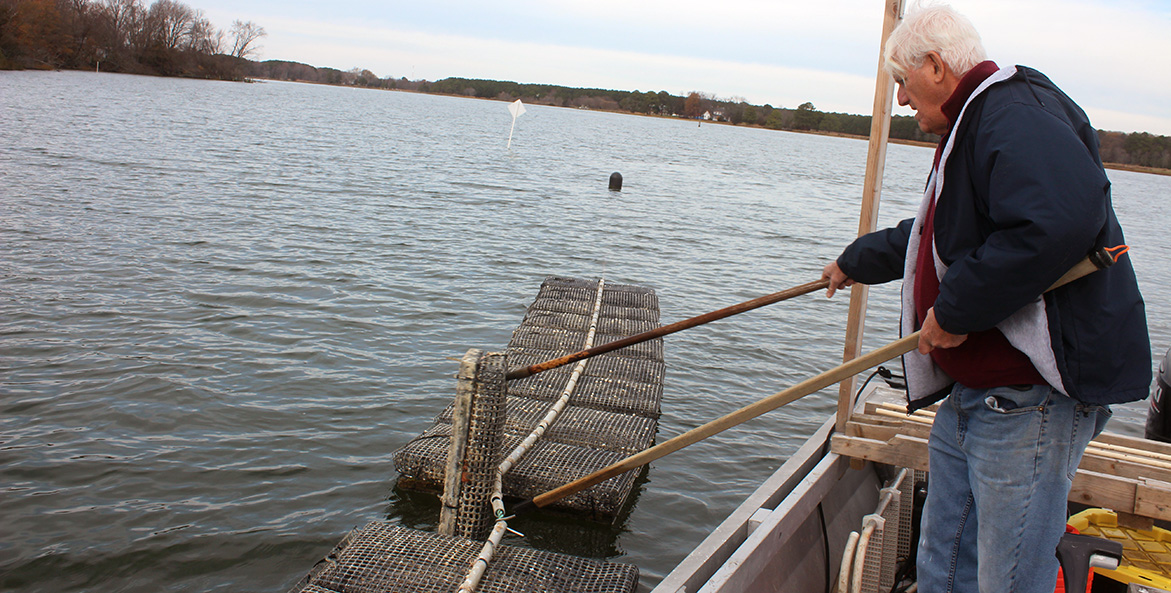Earlier this year, the Chesapeake Oyster Alliance (COA), of which CBF is a founding partner, awarded Oyster Girl Oysters a COA Oyster Innovation Award. The projects funded by COA are carefully selected for their potential to support impactful, progressive efforts related to oyster restoration, aquaculture, outreach, and research. The award to Oyster Girl Oysters supports a novel, low-cost system for flipping oyster cages, providing a technological solution that can vastly simplify the cage-flipping process, making oyster aquaculture more accessible to everyone.
Founded by Lawrence Rudner and Pamela Getson, Oyster Girl Oysters has evolved from a decade-long oyster-growing hobby into a commercial aquaculture operation in Harris Creek near St. Michaels, Maryland. They chose to grow oysters in cages at the water's surface to capitalize on natural currents and food availability. Compared to bottom-cultivated alternatives, this floating cage system results in faster growth rates and enhanced flavor profiles. While showcasing at the World Is Your Oyster Festival in Baltimore this past September, their oysters were described as “buttery, sweet, with a subtle salty finish.”
Their floating oyster cage approach also minimizes risks such as predation and siltation, contributing to a higher overall yield and survival rate. At Oyster Girl Oysters, these surface-grown oysters are cultivated using unique, mechanical flipping and harvesting tools, crafted by Rudner himself. The system consists of cages with a center axle and a special ramp secured to the boat. As the boat moves forward, the cages slide up the ramp, then flip when they reach the top based on gravity. "We want to increase efficiency while creating a more inclusive oyster growing experience,” explained Rudner.
On the farm, Rudner also shared traditional techniques for cage flipping, emphasizing the need for less physically intensive methods to encourage broader participation in oyster growing and harvesting. The experience served as a lesson in the delicate balance between tradition and innovation within the industry. As he shared his journey from oyster gardener to oyster farmer, Rudner's avant-garde approaches and dedication to inclusive farming methods illustrated the innovation potential that exists within the oyster industry. Throughout their journey, starting from scratch and consistently refining their techniques, Rudner and Getson have evolved into a dynamic entity, rooted in a passion for cultivating flavorful oysters in an environmentally, physically and, fiscally sustainable manner.
Rudner's innovative technology for flipping cages and harvesting oysters ensures operational efficiency with minimal physical effort while also providing biofouling solutions. Biofouling is a common issue within the oyster farming industry. It occurs when barnacles, sea grapes, algae, and other microorganisms accumulate on surfaces, like oysters and oyster cages. This potentially limits the growth and function of the farmed oysters. When utilizing a floating cage system to grow oysters at the water's surface, like Rudner and Getson, most farmers choose to flip the floating cages frequently to counteract biofouling. Routinely flipping the cages exposes the top side of the cage to the sun and air, desiccating what has accumulated on that side of the cage and inhibiting further growth from biofouling organisms. However, the effort required for this maintenance strategy can be physically taxing, especially as oysters grow and cages get heavier. Considering how this process can limit people’s participation in the aquaculture industry, Rudner wanted to find a solution to more efficiently flip oyster cages and harvest oysters.
In anticipation of the upcoming spring season, Oyster Girl Oysters has increased their cage count by 300 floating cages. While they are increasing the number of cages, their lease is still conveniently positioned within sight of their home, providing an ideal situation for easy experimentation and refinement. With the support of Chesapeake Oyster Alliance, Oyster Girl Oysters is eager to continue developing their cage flipping technology to increase farm efficiency and accessibility on their farm and throughout the aquaculture industry. COA is proud to support partners like Oyster Girl Oysters—partners that are committed to sustainability, accessibility, and innovation throughout the various sectors of the oyster world, all the while supporting COA’s goal of adding 10 billion oysters to the Bay by 2025.
Alexus Stelfox, Chesapeake Oyster Alliance Intern



